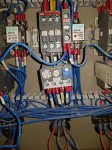lemonginger
Member
- Location
- Columbia
A friend of mine has a factory in Southeast Asia and was complaining that one of the motors at his factory keeps burning and had to fix the motor because the overload relay/breaker does not trip. His factory is 5 hours away from the main city and so getting a qualified electrician takes sometimes. And I also wanted to make sure I understand what the situation is before someone gives us wrong quote. I took some pictures to show you all what type of breakers/relays and motors are being used. I see that there is a setting dial set at 1.3. It looks like the size of the motor is small, 0.55kw. Is the breaker/relay too big for the motor? Is that why the relay does not trip? Any suggestions would be appreciated because I hate to see him keep fixing and replacing the motor. Where and how should the relay be set at? Thank you all!
ABB AX09
ABB CA5X
ABB AX09
ABB CA5X
Attachments
Last edited:




